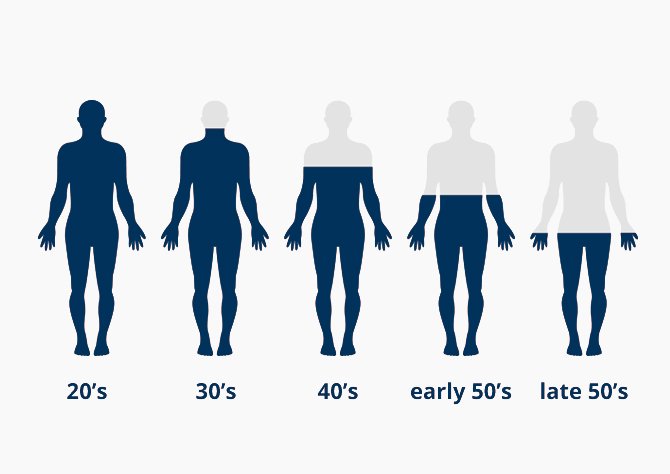Endocrinology of aging: andropause and testosterone
Andropause does not start at a precisely defined age, though natural aging represents a factor itself: the production of testosterone in a man usually start decreasing at around age 30 and continues throughout his whole life course. It is ordinarily found in men over 60 and, this extreme decline in the production of testosterone can be enhanced by other factors like being overweight, physical inactivity or the natural psychological decline, smoking also has a huge influence. Being overweight, however, is one of the main causes as the body will produce a significantly lower level of testosterone and, therefore, could cause this hormonal condition. This notion has led experts to define every occurrence of the symptoms with the general term androgen deficiency syndrome in old age, rather than andropause.
As we said, the symptoms of andropause are correlated with the production of testosterone. The reduction of the testicles due to age and the lower capacity of Leydig cells to produce this hormone affect the severity of the symptoms. The symptoms are quite varied because testosterone does not act only on the sexual level in men, but has direct influence on the metabolic, cardiovascular, locomotor, mental, behavioral and social dynamics of the individual.
This means that among the verifiable symptoms we also find some irritability, a natural decline in cognitive function and fragility of the bones. Yet it is possible to encounter weakness, loss of muscle strength, fatigue, decreased muscle mass, hair loss, abdominal obesity, depression and anxiety with erectile problems following a decreased libido.
These symptoms manifest in very different ways throughout a long period of time so, unfortunately, a simple test on the level of testosterone in the blood is often not enough for a precise diagnosis of andropause.
A healthy lifestyle, characterized by moderate exercise and a balanced diet, can be very useful for the prevention and treatment of this hormonal condition.
In these cases, a substitutive treatment with testosterone for a short period of time may be useful. Testosterone is the primary male hormone, essential for the development of sexual characteristics and the genitalia. Very often, this hormone is involved in the metabolism and it is used to cure genital as well as hormonal pathologies.
Testosterone is available in capsules, ampoules for intramuscular injection, gel and transdermal delivery patches. Each one of these methods have been tested and work well but, of course, they have pros and cons: the capsules do not guarantee a steady concentration in the blood, the patches are considered the most simple way to take the hormone, but they are more expensive. The testosterone gel formulation would seem to better reproduce the natural circadian rhythm of testosterone secretion.
During the first year of testosterone therapy, patients under treatment should undergo medical check-ups every three months. The clinical examination should include the evaluation of the prostate. These options, however, are contraindicated in cases of suspected or ascertained prostate cancer and male breast cancer.
Endocrinology of aging: andropause and testosterone Medical Tourism Italy
We have a strict policy about privacy and data usage:
- We will only use your contact information to take care of your case.
- Your phone number or email address will not be shared with any third parties.
- You will speak with a prepared Personal Health Planner with whom you can be 100% honest and upfront about any problem you’re experiencing.
- It is, and it will always be, 100% free.
